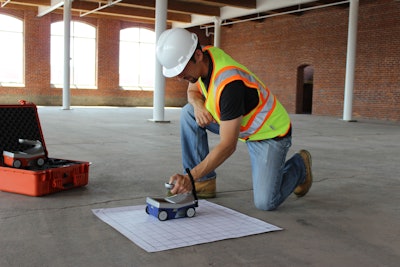Enhance Task Effectiveness with RainierGPR Concrete Scanning Providers
Enhance Task Effectiveness with RainierGPR Concrete Scanning Providers
Blog Article
Discovering the Midst: A Comprehensive Guide to Concrete Scanning and Its Diverse Applications
In the realm of construction and infrastructure growth, the careful process of concrete scanning holds an essential duty in making certain the structural honesty and security of tasks. As technology continues to develop, the applications of concrete scanning have actually broadened much beyond plain surface-level evaluations.
Significance of Concrete Scanning
Comprehending the relevance of concrete scanning is vital in making certain the safety and security and integrity of structures during building and construction and remodelling tasks. Concrete scanning makes use of innovative technologies such as ground-penetrating radar (GPR) and electromagnetic induction to spot ingrained objects, spaces, or other anomalies within concrete frameworks.
Furthermore, concrete scanning plays a pivotal duty in making sure compliance with building regulations and policies that mandate the defense of existing structural components throughout building tasks. By accurately drawing up the inner composition of concrete, scanning innovations enable building and construction specialists to make enlightened choices that promote the architectural stability and sturdiness of structures and facilities tasks. Fundamentally, the significance of concrete scanning depends on its capacity to safeguard both the structural stability and the personnel associated with building and construction endeavors.
Technologies Used in Concrete Scanning
Concrete scanning depends on innovative innovations such as ground-penetrating radar (GPR) and electromagnetic induction to precisely discover ingrained things and anomalies within concrete frameworks. Ground-penetrating radar runs by sending out high-frequency electromagnetic waves right into the concrete.
Electro-magnetic induction, on the various other hand, works by producing electro-magnetic areas around a concrete framework with a transmitter coil. When steel items exist within the concrete, they interfere with these electromagnetic fields, creating eddy currents to move with the metal. By measuring the changes in the magnetic fields with a receiver coil, the system can determine the place of metal objects in the concrete.
These advanced technologies play an essential duty in non-destructive screening, ensuring the security and integrity of concrete structures in various sectors.
Applications in Construction Market
Within the building sector, concrete scanning technology locates varied applications that enhance job effectiveness and safety. In addition, concrete scanning is made use of for situating gaps, such as air pockets or areas of degeneration within concrete, which can compromise the general toughness of a structure. Concrete scanning plays a vital role in high quality control by verifying the density of concrete covers over support, guaranteeing conformity with layout requirements and standards.

Safety And Security Benefits of Concrete Scanning
In the world of building safety, the application of concrete scanning modern technology presents a vital benefit in preemptively identifying prospective risks and strengthening architectural honesty. By utilizing advanced scanning approaches such as ground-penetrating radar (GPR) and electromagnetic induction, building teams can precisely locate rebar, post-tension cables, channels, and other covert things within concrete frameworks. This positive strategy considerably lowers the threat of unintentional strikes during drilling, reducing, or coring tasks, consequently protecting against expensive problems, injuries, and task delays.
Furthermore, concrete scanning improves worker safety by supplying real-time information concerning the architectural problem of concrete elements. This data allows building and construction professionals to examine the honesty of existing structures, recognize deterioration or issues, and make notified choices pertaining to repair and upkeep procedures. By dealing with prospective security issues quickly, concrete scanning adds to producing a safe working setting and alleviating the chance of architectural failures or accidents on building and construction websites. Inevitably, the safety advantages of concrete scanning not just guard lives and possessions however additionally support sector standards for top quality and integrity.
Future Patterns in Concrete Scanning
Emerging advancements in scanning modern technology are positioned see here now to transform the area of concrete assessment and evaluation. One significant trend that is obtaining traction is the assimilation of expert system (AI) and equipment discovering formulas right into concrete scanning tools. By harnessing the power of AI, these systems can analyze large amounts of data collected during scanning procedures to offer even more precise and comprehensive insights right into the problem of concrete structures. This can this website assist in finding hidden defects, forecasting prospective structural failures, and even suggesting maintenance techniques.
Another substantial fad is the growth of even more easy to use and portable scanning tools. Miniaturization of scanning equipment enables for much easier accessibility to restricted spaces and remote locations, making assessments a lot more effective and comprehensive. In addition, developments in wireless communication innovations make it possible for real-time data transfer and analysis, assisting in quicker decision-making procedures.
Moreover, there is an expanding concentrate on sustainability in concrete scanning modern technologies - RainierGPR Concrete Scanning. Makers are increasingly incorporating environmentally friendly products and energy-efficient features right into their tools to reduce environmental impact. These future patterns are readied to enhance the efficiency, precision, and sustainability of concrete scanning methods, shaping the market's future landscape
Verdict
Finally, concrete scanning plays an important duty in the construction sector by ensuring the safety and performance of different tasks. By using innovative innovations, such as GPR and radar imaging, experts have the ability to accurately detect prospective threats within concrete structures. The applications of concrete scanning are vast and remain to progress, making it an essential device for maintaining the integrity of structures and framework. As technology advances, the future of concrete scanning see holds promising growths for improving construction procedures.

Report this page